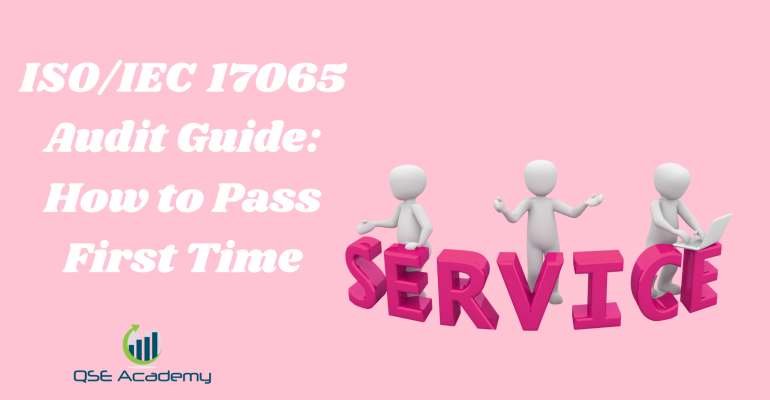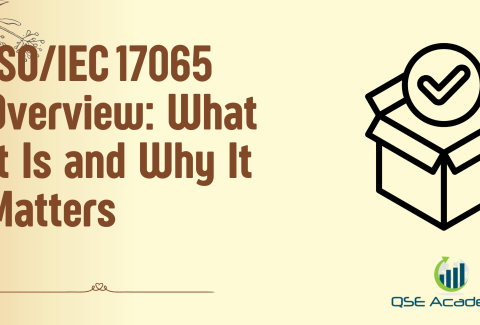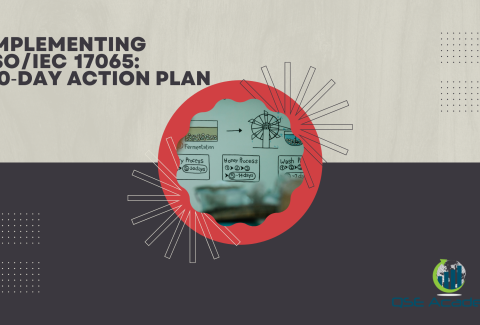ISO/IEC 17065 Audit Guide: How to Pass First Time
How to Approach the ISO/IEC 17065 Accreditation Audit with Confidence
Whenever I work with certification bodies preparing for ISO/IEC 17065 accreditation, one thing becomes obvious very quickly: the audit isn’t just a technical evaluation — it’s a demonstration of how well your system performs in real operations. Teams who prepare with intention feel calm and organized when the assessor walks in. Teams who scramble end up reacting instead of leading.
Here’s a quick story to illustrate what I mean. A certification body I supported years ago had good documentation, solid evaluators, and well-designed schemes. But before their first accreditation audit, they spent weeks “checking documents” instead of checking actual processes. When the assessor arrived, a simple question about sampling traceability stalled the entire team. After we regrouped, refocused on process clarity, and aligned everything with scheme rules, the reassessment went smoothly. The difference wasn’t extra paperwork — it was structured, intentional preparation.
This guide takes that same structured approach. You’ll see a clear roadmap covering documentation, impartiality, structural requirements, competence, process controls, internal audits, witness evaluations, file reviews, and corrective actions. By the end, you’ll know exactly what to expect and how to prepare to pass the audit the first time.
Understanding the ISO/IEC 17065 Accreditation Audit (Scope, Flow & Key Expectations)
An ISO/IEC 17065 accreditation audit is designed to verify one thing above all: your ability to deliver impartial, consistent, technically sound product-certification decisions. Assessors don’t just read documentation — they validate competence, decision-making integrity, evidence traceability, and operational control.
Here’s how the audit typically unfolds:
- Document review — assessors check procedures, schemes, records, impartiality controls, competence evidence.
- Witness assessment — they observe an evaluator in action.
- File review — they sample past cases to confirm consistency.
- Interviews — they speak with evaluators, decision-makers, impartiality committee members, and management.
- Closing meeting — they present findings, risks, and strengths.
Assessors expect clear alignment between procedures, scheme rules, and real practice. They want to see a system that works — not just one that looks good on paper.
A simple rule applies: the clearer your evidence, the smoother your audit.
 Foundation of Audit Readiness: Documentation, Procedures & Version Control
Foundation of Audit Readiness: Documentation, Procedures & Version Control
Strong documentation is your foundation. If your system has gaps here, everything downstream becomes difficult.
Your documentation should cover:
- Management system structure
- Impartiality controls
- Competence and qualification procedures
- Evaluation steps
- Decision-making process
- Scheme rules
- Complaints and appeals processes
- Internal audit and corrective-action procedures
- Forms, templates, and checklists
Version control is critical. Assessors don’t enjoy hunting through different versions of the same document. They want one controlled source of truth.
A good structure:
- One master document list
- One controlled repository
- Clear ownership of each document
- Version history and approval signatures
- Easy navigation for audit-day access
Consistency is everything. If documentation contradicts itself, the assessor will find it.
Strengthening Impartiality Controls (Clause 4 – The Most Scrutinized Area)
Impartiality is at the heart of ISO/IEC 17065. Assessors will examine your controls here with precision.
What they look for:
- Documented impartiality risk assessment
- Evidence of monitoring and mitigation
- Active impartiality committee involvement
- Clear documentation of conflicts of interest
- Separation of commercial, evaluation, and decision-making activities
This isn’t a one-time formality. Impartiality must be ongoing. Every new product scheme, new client, or new staff member introduces new risks.
Strong systems track these risks continuously. They meet regularly. They document decisions. They demonstrate real oversight — not symbolic compliance.
Structural Integrity & Role Separation (Clause 5 – Clear Lines of Responsibility)
Clause 5 is about clarity, transparency, and independence. Assessors want to confirm that your organizational structure supports unbiased certification decisions.
Critical elements include:
- A clear organizational chart
- Defined responsibilities for evaluators, reviewers, decision-makers
- Independence between evaluation and decision functions
- Documentation showing who approves what
- Evidence that structure supports impartiality
During interviews, assessors will test role clarity. If staff give inconsistent explanations, the assessor will assume structural weaknesses.
A strong structure is simple to describe, easy to understand, and consistently applied.
Competence & Training Requirements (Clause 6 – Evidence That Staff Know What They’re Doing)
Competence is one of the most common sources of audit findings. Assessors want proof that your team is qualified — not just by title, but by evidence.
You need:
- Competency criteria
- Training records
- Qualification requirements
- Evaluations of competence
- Ongoing competence monitoring
- Scheme-specific requirements
Your competency matrix should link roles to scheme-specific skills. General qualifications are not enough. If someone evaluates electrical products, their competence should align with that domain.
Assessors want to see traceability — training → evaluation → technical judgment → decision.
If competence evidence is scattered or inconsistent, findings will follow.
Process Requirements Mastery (Clause 7 – Evaluation, Testing & Certification Decisions)
Clause 7 is where you prove that your certification process is systematic, traceable, and aligned with scheme rules.
Assessors evaluate:
- Sampling logic
- Testing result review
- Evaluation report completeness
- Alignment with scheme rules
- Technical judgment clarity
- Decision independence
- Surveillance and recertification activities
Each step needs documentation and justification. Assessors dislike vague explanations. They want to see logic and alignment.
Strong systems map each step to scheme rules. Weak systems rely on individual interpretation — and that leads to findings.
Management System Requirements (Clause 8 – Internal Audits, Corrective Actions & Reviews)
Clause 8 demonstrates whether your system is being managed actively or passively. Assessors will examine your internal audit process, management reviews, complaints-handling, and corrective-action implementation.
You should be able to show:
- Internal audits based on risk
- Evidence of process verification
- Root-cause-based corrective actions
- Effectiveness checks
- Management review minutes
- Evidence of follow-up
Internal audits must test effectiveness — not just existence. If your internal audits are superficial, assessors will call out system maturity issues.
Corrective actions must address root causes, not symptoms. And they must show effectiveness validation.
Preparing for Witness Assessments (Live Demonstrations of Competence)
Witness assessments demonstrate real competence. Assessors want to see how your evaluator applies scheme rules, reviews evidence, and makes technical judgments.
Preparation steps:
- Rehearse the evaluation flow
- Review scheme rules
- Ensure evidence is complete
- Prepare evaluator notes
- Assign evaluator roles clearly
A confident evaluator who understands the scheme and explains the logic behind sampling, evaluation, and decisions is your strongest asset.
The goal is consistency, not performance.
Preparing for File Reviews (Evidence Sampling & Traceability Requirements)
File reviews validate your consistency across real cases.
Assessors sample past certifications and check:
- Evaluation reports
- Subcontractor results
- Testing records
- Sampling justification
- Certification decisions
- Surveillance follow-up
Your files must show:
- Completeness
- Traceability
- Version control
- Alignment with scheme rules
If one file is missing traceability, assessors will widen the sampling. The more gaps they find, the deeper they dig.
Preventing & Addressing ISO/IEC 17065 Non-Conformities (Corrective Actions That Work)
Corrective actions are your chance to prove process maturity. Assessors want to see that you can detect and fix systemic weaknesses — not just patch surface issues.
A strong corrective-action process includes:
- Immediate correction
- Root-cause analysis
- Long-term corrective action
- Evidence
- Verification of effectiveness
Common weaknesses:
- Generic corrective actions
- Weak root-cause analysis
- Lack of effectiveness checks
Strong systems monitor and re-evaluate. Weak systems repeat issues year after year.
Final Audit-Day Strategies (Communication, Flow & Evidence Confidence)
Audit day is about control, confidence, and clarity.
Useful strategies:
- Keep answers concise
- Always reference evidence
- Avoid guessing
- Let experts answer their domain-specific questions
- Maintain consistency between documentation and explanations
- Stay calm and organized
Assessors appreciate professionalism and preparedness. They don’t expect perfection — they expect clarity and evidence.
FAQs – ISO/IEC 17065 Audit Guide
How long does the accreditation audit take?
Usually 2–5 days depending on scheme complexity, scope, and the number of files sampled.
What causes most major non-conformities?
Impartiality, competence evidence, sampling logic, process misalignment, and documentation inconsistencies.
Is it possible to pass the audit the first time?
Yes — with structured preparation, strong evidence traceability, and confident process control.
Conclusion: Build a Strong, Predictable ISO/IEC 17065 Audit Outcome
Passing your ISO/IEC 17065 accreditation audit the first time is completely achievable when preparation is structured around real operational control — not last-minute document checking. Focus on documentation clarity, impartiality oversight, competence demonstration, process alignment, strong internal audits, effective corrective actions, and controlled witness/file sessions.
A well-prepared certification body doesn’t hope for a smooth audit — it ensures it.
Melissa Lavaro is a seasoned ISO consultant and an enthusiastic advocate for quality management standards. With a rich experience in conducting audits and providing consultancy services, Melissa specializes in helping organizations implement and adapt to ISO standards. Her passion for quality management is evident in her hands-on approach and deep understanding of the regulatory frameworks. Melissa’s expertise and energetic commitment make her a sought-after consultant, dedicated to elevating organizational compliance and performance through practical, insightful guidance.









